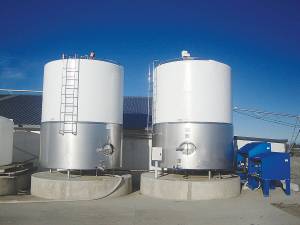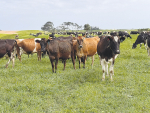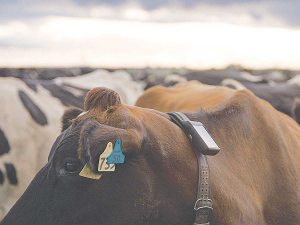Therefore, choosing the right cooling system for your farm means less energy costs for the farmer and less risk of penalties linked to milk temperature.
According to DairyNZ, milk cooling accounts for about 30% of the total energy costs of operating a dairy.
Energy demand and farm dairy operating costs can be reduced using different options that involve heat recovery from your cooling system. Here are some of the milk cooling systems available in New Zealand:
Ice Bank
The Ice Bank solution works by building a mass of ice between milkings. Then, during milking, water is circulated through the ice, reducing the water temperature to near zero degrees.
The chilled water is passed through a double bank plate cooler to cool milk to approximately 4°C before it reaches the vat.
Warmed water generated from the milking process is returned to the ice bank and cooled again.
It boasts a smaller footprint and better efficiency.
A small footprint means the Ice Bank can easily be accommodated in existing dairy parlours, and is ideal for herds of up to 600 cows, but can also be sized for larger herds.
It manufactures ice between milkings with little or no impact on electricity supply, and minimises the amount of water required.
Milk enters the milk vat at the industry standard, generally around 6°C, but can enter the vat from 5°C depending on the farm's logistics. Existing units can sometimes be used to run the Ice Bank and cool the milk once it has entered the vat.
Smaller sized systems are delivered to site, tested and filled with refrigerant, greatly reducing the cost of an initial installation.
Water chilling solution
An all-in-one pre-cooling water chiller solution can include a plug-in chiller unit with the option of a pre-plumbed water holding tank. Thermal storage systems use a large storage tank to hold and chill a large volume of water. They are easily installed and maintained and are a common form of farm pre-cooling system in New Zealand.
The mix and match system can be configured to meet farming needs. All components are designed for optimum system performance. All components, fittings and polyethylene pipes are included and delivered to farm ready for install, reducing time and cost. The pre-welded plastic joins in the tank reduce the likelihood of leaks.
Heat recovery can be added to the water chiller to efficiently heat dairy shed water.
Suitable for all dairy farm sizes, the Water Chiller requires sufficient space to accommodate a water tank and water chilling unit - and depending on the volume of milk per milking, the water tank size can vary from 10,000 to 30,000 litres.
The size of the Water Chiller unit and volume of the water tank determines how long it takes to bring the water in the tank down to the recommended temperature - often around 6°Cm enabling milk to enter the milk vat at around 9°C.
The chiller on the vat then reduces and maintains the milk temperature to the industry standard, generally between 4°C and 6°C.
Similar to Ice Banks, the unit chills milk between milkings with little or no impact on electricity supply, with the chilled water cooling the milk through the on-farm plate cooler.
On-demand snap chilling
Farms can rapidly reduce milk temperature with glycol precooling. These systems use a mixture of food-grade glycol and water to create the chilled fluid on demand, at milking time. With a correctly sized refrigeration unit, the system can chill mix to 4°C before entering the vat.
The compact glycol solution is ideal for farms with high water temperatures and a good supply of power during the milking period.
Glycol Snap Chilling units are ideal for large, continuous 24/7 farming operations, new parlours with more than six hour milkings, or large herd farms - due to the specific levels of electricity required.
Powered by inverter technology, Glycol Snap Chilling units are able to ramp up to match the load required and deliver power savings of up to 40% over standard compressors.
Each Glycol unit is sized to ensure the milk temperature is approximately 6°C when it enters the milk vat - and a backup unit on the base of the tank is recommended to keep the milk to the industry standard while in the milk vat. Glycol chilling can also be supplied with standard technology.
Polar wrap vat insulation
Durable high-quality vat insulation saves power by reducing the effects of outside temperatures and will help milk chill faster.
For farmers on the cusp of compliance, vat insulation may save them needing to invest in more costly cooling systems.
Milk vat chilling
Milk vat chilling is another cost-effective option for farms whose milk is collected every other day.
The milk vat chilling system chills milk once it is in the milk vat, and utilises and electronic valves to ensure precise load matching and maximum energy efficiency.
Vertical air discharge, with fan variable speed drive, maximises heat rejection regardless of the wind direction, optimising performance in all ambient temperatures.
The efficiency of the unit to chill milk below 10°C is reliant on cool water temperatures. The milk vat chilling system can be easily retrofitted into existing dairy parlours between milkings.











